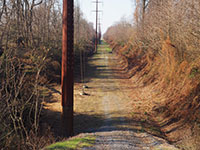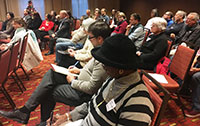The Chester County Planning Commission accomplished many goals in 2017. The staff was incredibly busy helping plan for the county’s future. Here is a brief recap of the accomplishments of 2017 and how these accomplishments helped implement Landscapes2 and smart growth.
Landscapes3
Work on the county’s new comprehensive plan continued throughout the year, with virtually every person in the department involved in some aspect of the plan update. In 2017, we:
- Held seven topic-specific stakeholder meetings, bringing together partners to discuss issues and potential solutions to issues facing the county.
- Encouraged the public to provide input, which yielded nearly 6,000 responses to a survey, 250 submissions to a photo contest, and 50 attendees at our public meeting. We also spoke to hundreds of county residents at 26 local events.
- Began holding steering committee meetings where members developed a draft vision, goals, objectives, and landscapes map for the plan.
- Presented plan issues to various partners, such as the Chester County Association of Township Officials, municipal managers, municipal solicitors, municipal engineers, and the Delaware Valley Regional Planning Commission.
- Prepared four videos that highlighted the role of planning in the county.
Helping Municipalities Implement Smart Growth
Local municipalities are on the front lines of implementing smart growth, which focuses on new, walkable development in urban and suburban centers while preserving rural and agricultural areas.
Many county municipalities are currently working on comprehensive plans, zoning ordinances, and other planning tools for smart growth. Here are a few completed Vision Partnership Program (VPP) projects from 2017 and how they implemented Landscapes2:
- East Pikeland adopted an updated zoning ordinance for Kimberton Village that promotes appropriate growth in the village as long as the new development respects the historic character of the village and is pedestrian friendly.
- West Chester adopted a comprehensive plan that developed strategies for preserving the town’s historic character, maintaining its economic vitality, improving environmental sustainability, and accommodating a university.
- Caln adopted a comprehensive plan that encourages growth along Route 30 and near the township’s train station, particularly walkable mixed-use and apartment development.
Providing More Transportation Alternatives
We continued to work hard to expand transportation alternatives and improve the overall transportation network. The county, the Pennsylvania Department of Transportation (PennDOT), and other partners:
- Completed a Mill Trail study in the Coatesville region and an East-West Bicycle and Pedestrian Facilities Plan for connecting Hibernia Park with the Struble Trail.
- Developed four walking routes in three urban centers as part of the WalkWorks program. These routes are designed to make walking enjoyable and interesting, with the hope that additional walking will improve residents’ health.
- Completed the Chester Valley Trail Extension to Downingtown study and coordinated with PennDOT on using the inactive Philadelphia and T
 horndale rail right-of-way for this trail extension.
horndale rail right-of-way for this trail extension. - Began work on the Chester Valley Trail West study to determine the remainder of the alignment in Chester County to connect with the Enola Low Grade Trail in Atglen.
- Started reconstruction of the Exton and Paoli regional rail stations.
- Moved forward on acquiring right-of-way for the Schuylkill River Trail between Parker Ford and Pottstown.
- Celebrated the rapid construction of a new bridge carrying Route 926 over the Brandywine Creek in Pocopson.
- Saw the installation of a fourth roundabout in the county at the convergence of Strasburg and Romansville roads in West Bradford.
Learn more about transportation in Chester County.
Protecting Open Space, Preserving Historic Landscapes, and Keeping Agricultural Land
A key part of Landscapes2 is preservation, and it’s an important part of our mission. In 2017, the Planning Commission and the county:
- Coordinated town tours throughout the summer, with over 2,300 total participants.
- Tracked open space preservation, identifying over 27 percent of the county as protected open space at the start of 2017. During the year, there were a number of significant open space successes, such as the preservation of Bryn Coed Farms.
- Repaired and reopened the damaged covered bridge carrying Hollow Road over French Creek between East Vincent and West Vincent.
- With the Agricultural Development Council, produced the Farm Guide, ACRE info sheet, and other materials designed to strengthen agriculture.
Encouraging Revitalization of Urban Centers and Underutilized Suburban Land
Smart growth involves revitalization of urban and suburban areas. In 2017, we:

- Completed an award-winning Commercial Landscapes planning series that included policy guides for walkable, mixed-use revitalization of office parks, brownfield sites, train station areas, and retail commercial sites.
- Supported an Urban Centers Forum focused on parking in downtown areas.
- Provided technical support to urban centers through the VPP, coordination of meetings between municipalities and economic development advocates, and updates to the urban centers’ lists of infrastructure projects.
Reviewing Plans for Consistency with Landscapes2 and Smart Growth Planning
In 2017, the total number of proposed homes dipped slightly, and although multifamily remained the largest housing type (1,450 units out of 3,100 versus 2,200 out of 3,400 in 2016), townhouses (810 versus 680), twins (170 versus 70), and single-family detached homes (660 versus 380) grew as a share of the total number of housing units. Much of the proposed development remained in core employment and development areas, including Phoenixville, Great Valley, Exton, West Chester, Downingtown, and Kennett.
- Residential units dropped slightly, falling from approximately 3,400 units in 2016 to 3,100 in 2017.
- Non-residential square footage returned to its 2015 level, dropping from about 3.1 million in 2016 to 2.7 million in 2017.
During the year, we also reminded municipalities of our sketch plan services and began providing redesigns of sites to enhance projects and preserve important site elements.
Although not reflected in the new proposal data, many older approved developments that had been on hold began construction in 2017, and many of these were for single-family homes.
Learn more about plan reviews in Chester County.
Providing Information and Data to the Public
In addition to implementing Landscapes2, a key function of the agency is to provide information and data to the public. In 2017, the Planning Commission:
- Continuously updated the Pipeline Information Center with new information.
- Analyzed housing prices and construction.
- Worked with local municipalities and the U.S. Census Bureau on the 2020 Census.
- Updated various data and map areas on the website.
Improving Communication with our Partners and the Public
Communicating our information and policies is critical. A key initiative for improved communication included a new website, chescoplanning.org, which is full of detailed information on a wide range of topics.
Creating New Goals for 2018
The primary task of the Planning Commission in 2018 will be wrapping up Landscapes3. During the year, the Landscapes3 Steering Committee will build on the draft goals and objectives written in 2017 by developing specific recommendations for implementing the goals. Throughout the process, there will be many opportunities for the public, local municipalities, and other partners to give input.
Other key 2018 projects will include a study of the Chester Valley Trail West project, an update of our online etools, the start of a housing diversity guide, guidance on parking for urban centers, and a Phoenixville Region Multimodal Transportation Plan. The Planning Commission also will be continuing the VPP for municipal planning, reviewing proposed land developments, providing up-to-date data and mapping, and conducting several other projects to help keep Chester County a great place for residents, businesses, and visitors.
Connect with us on Facebook, Twitter or LinkedIn or visit us online at www.chescoplanning.org to stay informed about our latest initiatives.

it possible to meet with someone to discuss plans for Chester County?